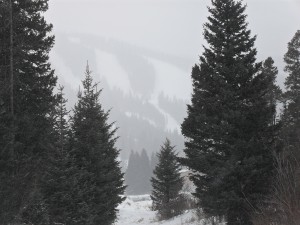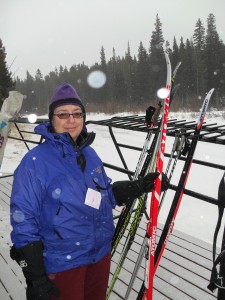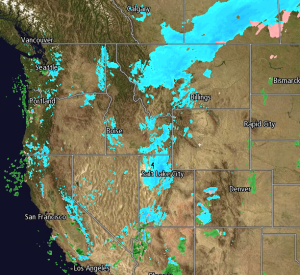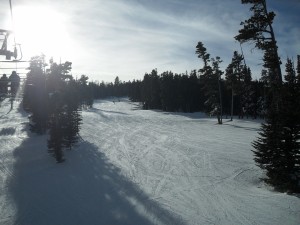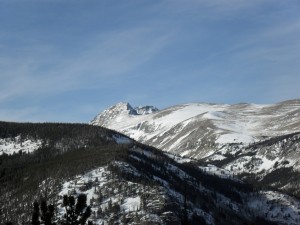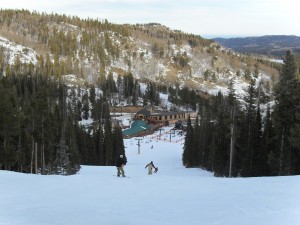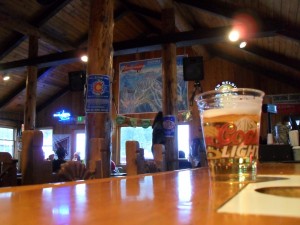Nordic Skiing at Eldora
View of the frontside downhill runs from the edgeof the Nordic area.
On Sunday Shelly and I went up to check out the tracks around Eldora’s Nordic center. This is an area of cross country ski trails that are maintained by the Eldora ski resort. Lots of ski resorts in Colorado have these areas. You might ask, why go to a pay area when there are literally hundreds of miles of free terrain to back country ski near Boulder? Well, we went up to skate ski and that requires a groomed trail. Skate skiing is just what it sounds like, you propel yourself along a trail using a skating motion, like ice skating on skis. The skis are designed to optimize this motion and you can get an excellent workout in the wintry mountains this way.
The first thing we noticed was the cold! It was about zero degrees Fahrenheit, cold enough that we both kept on a couple of layers even during the workout. That’s rare, especially for someone like me who, during a workout tends to generate enough heat to boil water.The second thing was that even though we had gotten some new snow, it wasn’t enough to make up for the very thin cover. Many of the Nordic tracks were closed due to lack of sufficient snow and even the trails that were open had many rock hazards. This is a problem, if you ski over a rock you tend to stop immediately resulting in a faceplant. Check out the pic of The Stadium, an oval field you can normally run laps around. You can see the grass poking out. This is usually a completely white snowfield this time of year.
So…. The next problem was that we couldn’t get any glide! Either because of the cold or snow conditions, or both, our skis were too sticky to skate without a tremendous effort. We overheard complaints from the few others out there on skate skis as well. This would have been a better classic ski day, we decided, but we didn’t bring our other skis and had to “suffer” with what we had. I was OK with just being outside as you might see. Shelly was not as enthusiastic but wanted a workout. I took a pic just outside the Nordic Center building. The white spots are close-up snow flakes. She is “enjoying” the cold. As is usually the case with these kinds of outings, we’ll suffer with poor conditions for a while before giving up. And it was about an hour. Really, it’s part of the adventure, right?
On the upside, Shelly discovered the perfect recipe for hot chocolate. We both agreed that it was the best we’d ever had and made up for a lot. We drank most of it back in the heated car!
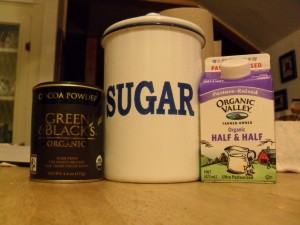
Two cups boiling water
Three tablespoons Green and Black’s powdered cocoa
One tablespoon raw sugar
Some Half-n-Half
Well, not all adventures turn out great but live and learn, next time we’ll bring more ski options and there’s always next week!
Posted in Trip Reports by Mark with comments disabled.
Snow is coming!
OK, well after a couple of weeks of temps getting up into the 60s, we’re ready for some snow on the Front Range. Looks like it’s coming. The CAIC forecast for this afternoon:
High clouds are streaming into Colorado from the west and southwest as the next winter storm approaches. This system is a very large low-pressure trough with lots of cold air.
The storm looks big on the radar:
Mountains are supposed to get 2-7 inches new snow. Cool! Maybe we can get some backcountry skiing in this weekend.
Posted in Uncategorized by Mark with comments disabled.
Eldora Ski

Eldora is a small downhill ski “resort” in the mountains above Boulder, Colorado. Hardcore skiers like to dis Eldora, it is much smaller than the major resorts in Colorado and lacks the amenities of those big resorts. But it does have two things going for it: Convenience to Boulder, only about thirty minutes away with no I-70 traffic madness, and the fact that most skiers are not that “extreme” and have as much fun there as anywhere.
I drove up last Sunday afternoon to end my weekend on the slopes. This is a perfect time to ski as the crowds are thinning by this time and close-in parking is opening up. Yeah, I used to get up at zero-dark-thirty to join the frenetic crowd and still only got a half day of “real” skiing. The Sunday afternoon approach is much more relaxed and enjoyable, and no long lift lines. No lift lines at all actually.
It was comfortably warm Sunday, like spring skiing, and the infamous wind was not blowing. With no lift lines I found myself on the summit in no time. A fast descent on somewhat below average snow got me to the base of one of the backside lifts.
It was nearly abandoned with no customers waiting and one lift operator. On the ride up I saw only a few hints of skiers (photo above). Another fast ski down on my first day of downhill skiing this year got me to the base of the Corona lift. Despite warm temps and no snowfall for a week and a half, the snow was OK with a moderate number of icy patches. I rode up the Corona lift, this is the edge of the ski area.
From the Corona lift you get a great view of the Arapaho peaks, a popular hike or winter climb I wrote about here. They can also be dangerous of course and are an infamous location for Rocky Mountain Rescue missions. They look very peaceful today, though.
Though I prefer backcountry skiing, one thing I always enjoyed about ski resorts besides the fun of many downhill runs in a row is the way you can be in the outdoors in relative comfort. Despite all the trappings of civilization that go with resort skiing, you are still outside in the mountain wilderness. You can smell the pine forest, feel the cold air on your skin, the sharp breaths, and take in the beautiful snow-covered surroundings. It’s not a simple appreciation of nature, you become part if it. You understand what it means to be into it.
Being the first downhill ski day of the year and the lack of crowds to enforce breaks between runs, my quads were soon burning.
I took one run beyond my limit (feel the burn!) and spotted the lodge below. It was about 4:00 pm, man it starts getting dark early this time of year. And it got colder. Definitely time to call it quits. Of course, no ski day is complete without a visit to the local watering hole. The bar at Eldora is quite rustic but cozy. The greatest thing about it is you can order a simple hot dog and it’s not even a kids menu item! Of course there are better restaurant choices in Nederland, but that’s for another report.
Cheers!
Posted in Trip Reports by Mark with comments disabled.
Journal

Another good ice climbing article here. It tells a more objective story about why people climb ice, at least why the more gonzo climbers do it.
The article mentions an RMR collegue of mine who describes losing a crampon while leading an ice formation in Cody, Wyoming. He finished the climb using only the leg with the securely attached crampon. Scary stuff. It happens more often than you think.
It happened to me in 1994 at 24,000 feet on Makalu when a crampon slipped off my overboots. I saw it just in time and was able to fix it, and several of us rescued a British mountaineer on Manaslu in 1996 who was dangling by a single ice tool holding him from dropping thousands of feet down an ice chute to certain death. Both of his crampons had come off his boots due to misfitting. We were able to tie him off and belay him to safety. I saw it happen again in 2005 on Pisco in Peru, this time due to a manufacturing defect in the crampon. We had to rig up a fix to complete the descent on an ice glacier and ended up overnighting high on the mountain due to the time it took to fix the crampon and descend slowly.
Bottom line: Make sure you use a proper boot/crampon combination (they don’t always fit together) and check the crampons occasionally during the climb to make sure they haven’t loosened.
Surprising news, the iconic Boulder mountaineering store Neptune Mountaineering has been sold to a Texas based outdoor chain. Well wishes to Gary and goodbye to a longtime Boulder landmark.
Coming soon, last weekend’s excursion to Eldora!
Posted in Journal by Mark with comments disabled.
Ouray Ice Climbing

The Ouray Ice Festival is in full swing this week at the Ouray Ice Park.. Below is an article I wrote for Mountain Gazette a few years back:
Colorado Ice Climbing
I was reclining under a dark January sky as enormous snowflakes lighted on my face, feeling like a shower of tingling cold pinpoints. It was an excellent sensory contrast to the soothing hot water in which the rest of my body was submerged. The round wooden tub was fed directly from a natural hot spring behind the Box Canyon Lodge, and was positioned on a hill overlooking the mountain village of Ouray, Colorado.
I quaffed a cold beer, enjoying glimpses of town light glowing on the gray walls of the surrounding valley, walls that rose into a night fog so dense it could conceal this mountain refuge from the world of industry and schedules.
The sound of women laughing in the next tub wafted through the mist. “Yes… He’s a friend of mine and I talked him into letting me use his tool,” one of the women said. Another giggled in reply, “Well, what was it like?”
“It was fantastic!” she exclaimed, “The shaft had an easy grip and the length was perfect. The curve felt kind of strange, but believe me, when I got busy it made all the difference.”
“Did you get wet?” a third woman asked. “Of course! How could I do it without getting wet, silly? You should try it!” They all laughed.
Yeah. Ice climbing. In Ouray, the ice climbing capitol of the West, you rarely hear talk of much else. I took a deep breath of the crisp, pine-tinged atmosphere well below freezing. As I kneaded stiff muscles in the calescent pool, I reflected on my need to ritualistically suffer on frigid walls of ice. The motivations are complex, but let’s immediately put to rest the idea that ice climbing is merely another sport for adrenalized thrill-seekers attempting to live on the edge.
Of all my climbing experiences, from the thin air of high-altitude mountaineering to roped technical rock, ice climbing is uniquely gratifying. Unlike a rock route literally fixed in stone, the line of an ice route is essentially as you choose it. It is like the difference between a resort skier descending a groomed run versus a telemark skier savoring first powder tracks in a backcountry bowl.
On ice you must be completely self-reliant. Because your life and limb depend on your actions, you are forced into Zen-like clarity of mind directed at your very place and moment. Like a Buddhist master, you are fully immersed in here and now.
At the finish of a difficult route, you enjoy the victory of having crafted your own line of ascent. It is not uncommon to feel like a prophet reeling from a metaphysical vision. Your core spirit is energized, enlightened, and you know you are alive.
Much of the time that vision extracts a toll. Among the most-common and excruciating experiences ice climbers suffer is the rewarming of hands. The thickest practical gloves used by ice climbers cannot perfectly insulate. And gripping an ice tool above your head further drives the blood from your fingers.
Re-establishing full blood flow can be tortuous. Your fingers feel as if they are being crushed by pliers as a blowtorch sears your flesh. No kidding. It is perhaps one of the most painful experiences possible that does no actual harm. There is no relief as your world spins in eye-watering agony for several minutes.
By the time the water had re-warmed my body, the snow had accumulated two inches outside the tub. I scurried to my room with my hair and beard encased in ice. After drying off, I dressed and hiked a few blocks to Buen Tiempo, a bar famous for warming fleece-clad climber’s fresh off the ice. I sipped margs with climbing buddies old and new, laughed at our ice follies, admired tales of difficult ascents and anticipated ambitious plans for the next day. Climbers from Colorado and beyond crowded in and loud conversation reverberated off the walls. We were a tribe celebrating our bonding rite.
The next morning I was shivering in knee-deep snow at the base of a blue-gray ice wall, intentionally stripped down to minimal clothing. I would soon work myself into a sweat. I struggled to tie into a frozen-stiff rope. I swung an ice tool, sinking the pick into plastic ice. I repeated the action with my other tool. I then kicked my right foot into the ice knee-high, sticking my crampon frontpoint perpendicular to the wall. I stepped up. I alternated this action, tool and crampon, until I was twenty feet above the ground.
I twisted a screw into crackling ice. Frigid water that was running down the wall also ran into my sleeve, sending a cold rivulet down my arm and torso. I clipped my rope and continued up, shoulders and calves burning. I hammered the ice and unintentionally cracked off a chunk the size of a dinner plate above me. It nailed me in the face, drawing blood and swelling my lower lip. I looked like I was on the losing end of a bar fight. I continued up.
The ice constantly changes. I love it.
—Mark Scott-Nash

Posted in Uncategorized by Mark with comments disabled.
The Snow is in Steamboat!
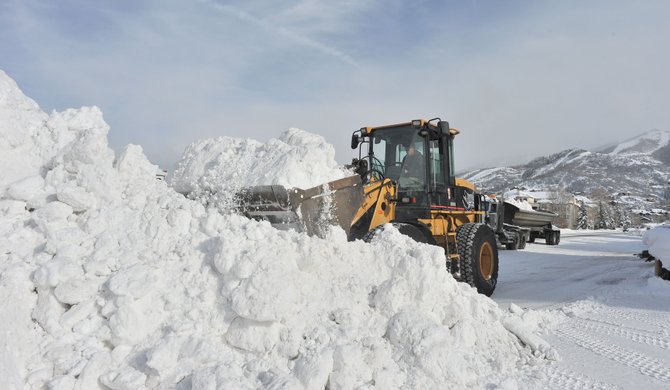
Photo by John F. Russell, published in the Steamboat Pilot and Today.
Though the Front Range continues to struggle with moderate to low snow depth, the Steamboat area is doing great! Snowfall totals for December is 66.9 inches, the sixth highest recorded.
Though Steamboat is well-known for its downhill ski resort, remember that it is surrounded by vast tracts of stunningly beautiful wilderness that sees very few visitors, only about two and a half hours from the west side of Denver, assuming you avoid the I-70 jam-ups, that is…
Posted in Uncategorized by Mark with comments disabled.
Colorado man among two mountaineers killed on Argentina climb – The Denver Post
Aconcagua is technically very easy by its popular routes, the normal route is like hiking Mt. Bierstadt. But at nearly 23,000 feet high, the extreme altitude and weather produce a regular death toll even to very experienced climbers:
Colorado man among two mountaineers killed on Argentina climb – The Denver Post.
Posted in Uncategorized by Mark with comments disabled.
Journal
The New Year is upon us! This is day 1 of my year long outdoor blog project.
The storms in the last week of December have (finally!) produced good to excellent backcountry ski conditions for the beginning of this year. Keep the snow coming!
On a sad note, the end of last year saw the seasons first avalanche fatality. Patsy Hileman, a highly experienced professional ski patroller in Snowmass was caught in a snow slide and swept over a cliff. She died of “blunt force trauma” as opposed to suffocation. This accident emphasizes two important characteristics of avalanche fatalities: Professionals such as ski patrollers are statistically more likely to be caught in an avalanche, and that many times injuries and fatalities suffered by avalanche victims are caused by trauma. All the training and emphasis on the use of avi beacons, such as quick searches and digging out the victim, tend to give people the impression that burial and suffocation are the biggest danger with avalanches. Not necessarily true. An avalanche beacon doesn’t offer much help against hitting boulders and trees, or going over a cliff. If you think a slope may avalanche, it’s wise to avoid it.
If we’re lucky, 2013 could be the year of the comets.
Posted in Journal by Mark with 1 comment.
